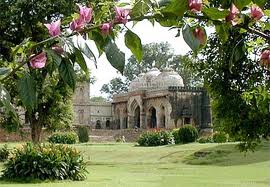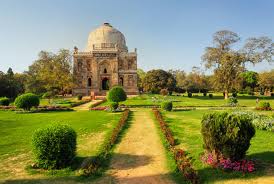Lodhi Garden
Book Now
Lodhi Garden in Delhi
The Lodhi Gardens is a recreational area in Delhi, situated between Khan Market and Safdarjung's Tomb on Lodhi Road. The garden in the beginning was a village that was surrounded by monuments from the Sayyid and Lodhi rule. Lodi Gardens is a historic park spread over 90 acres in the heart of New Delhi. Lodi Gardens has historical monuments built during the fifteenth and sixteenth centuries. Then there is a great park with spread out lawns, trees, plants and flowers. Visiting Lodhi Gardens can be a unique way of experiencing history and nature. It is also one of the finest places for taking a morning walk. Lodhi Road. The garden in the beginning was a village that was surrounded by monuments from the Sayyid and Lodhi rule. Lodi Gardens is a historic park spread over 90 acres in the heart of New Delhi. Lodi Gardens has historical monuments built during the fifteenth and sixteenth centuries. Then there is a great park with spread out lawns, trees, plants and flowers. Visiting Lodhi Gardens can be a unique way of experiencing history and nature. It is also one of the finest places for taking a morning walk.
History of Lodhi Garden
 The Lodhi gardens were laid out in 1936 around four monuments of the Lodhi dynasty - Mohammed Shah's Tomb, Sikander Lodhi's Tomb, Sheesh Gumbad and Bara Gumbad. The earliest of these, the tomb of Mohammed Shah, was built in 1444 by Ala-ud-din Alam Shah in honor of Mohammed Shah. Bara Gumbad and an adjacent mosque were constructed in 1494 during the reign of Sikander Lodhi. Sheesh Gumbad, which stands opposite, was built around the same time. Finally, Sikander's own tomb was constructed by Ibrahim Lodhi in 1517. The Lodhi gardens were laid out in 1936 around four monuments of the Lodhi dynasty - Mohammed Shah's Tomb, Sikander Lodhi's Tomb, Sheesh Gumbad and Bara Gumbad. The earliest of these, the tomb of Mohammed Shah, was built in 1444 by Ala-ud-din Alam Shah in honor of Mohammed Shah. Bara Gumbad and an adjacent mosque were constructed in 1494 during the reign of Sikander Lodhi. Sheesh Gumbad, which stands opposite, was built around the same time. Finally, Sikander's own tomb was constructed by Ibrahim Lodhi in 1517.
Due to its aristocratic and well known location, the Lodhi Gardens can be located easily. In the middle of these beautiful gardens is the Bara Gumbad or the "Big Dome" and Sheesh Gumbad or the ‘mirror dome’. The beautiful remains of the then ruling empires are truly attention-grabbing. This place is a must visit and a much needed escape from the hustle and bustle of the city life.
Architecture of Lodhi Garden
Lodi Gardens was landscaped by Lady Willingdon in 1936. Lady Willingdon was the wife of Marquess of Willingdon, Governor-General of India during the British Raj at that time. It was re-landscaped by American landscape architects Joseph Allen Stein and Garrett Eckbo in 1968.
The Tomb of Mohammad Shah: Mohammad Shah was the third ruler of the Delhi sultanate in India from the Sayyid dynasty. Mohammad Shah ruled from 1434 to 1444. The tomb was built by his son, Ala-ud-Din Alam Shah in the year 1444. Mohammad Shah’s tomb is close to an entrance to the Gardens and is visible from the main road outside. Sayyid dynasty. Mohammad Shah ruled from 1434 to 1444. The tomb was built by his son, Ala-ud-Din Alam Shah in the year 1444. Mohammad Shah’s tomb is close to an entrance to the Gardens and is visible from the main road outside.
Sheesh Gumbad: Sheesh Gumbad, or Glass Dome, called so because of the blue tiles that adorned it earlier. Some of the remnants of these tiles can be seen at the fop of the facade now also. Sheesh Gumbad has been dated as built sometime in the late fifteenth or early sixteenth century and has graves of an unknown family. Sheesh Gumbad is square in plan whereas a lot of other monuments of the same era are octagonal. It has a striking white dome and the stone walls have a good finish. The landscape around gives it a great background and the view is simply superb.
Bara Gumbad: Bara Gumbad, or Big Dome, is a square tomb with a predominant white dome, built during the Lodi period (1451-1526). There is also Bara Gumbad Mosque, with three domes and five arched openings. The interior of the mosque is heavily decorated with florals, geometric designs and holy inscriptions. The hall in front of the mosque served as a guest house. There are remains of a water tank in the courtyard.
The Tomb of Sikandar Lodhi: Sikandar Lodi was the ruler of Delhi Sultanate from 1489 to 1517, being the second ruler of the Lodi dynasty. The tomb was built by his son, Ibrahim Lodi, after Sikandar Lodi’s death, in the year 1517. Sikandar Lodi’s tomb is well inside the Lodi Gardens and there is an elaborate boundary wall which gives a unique peaceful environment inside the tomb. The tomb is octagonal, with three arched openings on the sides. There are a lot of trees in the garden around the tomb and the birds chirp a lot and the overall atmosphere is very serene.
Athpula Bridge: Athpula, or Eight-piered, bridge is a heritage stone bridge built by Nawab Bahadur, a nobleman in the court of great Mughal emperor Akbar. It was built sometime during the late sixteenth century. The bridge has seven spans or arches and, thus, is supported by eight piers. The bridge stands over the remains of what was once a tributary of the river Yamuna. It is also known as Khairpur ka Pul.
Landscape : The landscape is simply superb. There are walking trails, jogging tracks, open spaces, trees, flowers and a lot of shade from sunshine. Some of the scenery is captured in the pictures below.
More Info
Location: On the main Lodi Road, about a kilometer east of Safdarjang tomb
Time to Visit: Open on all days
Entry Fee: Free and open to all
How to Reach: Tourists can either take local buses from various points within the city to reach the gardens, or they can auto-rickshaws and taxis or metro rail.
|